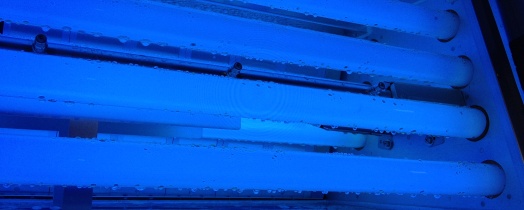Artificial ageing by combined exposure to radiation, humidity and temperature
| Measurement |
Change of material and component properties, e.g. strength, hardness, embrittlement, chalking, fading, transmittance, emissivity, yellowing, geometry |
| Standards |
DIN EN 927-6, DIN EN 1297, DIN EN 1898, DIN EN 12224, DIN EN 12543-4, DIN EN 13523-10, DIN EN 75220, DIN EN ISO 4892-1, DIN EN ISO 4892-2, DIN EN ISO 4892-3, DIN EN ISO 11507, DIN EN ISO 11895, DIN EN ISO 11997-2, ASTM D 3424, ASTM D 4329, ASTM D 4587, ASTM D 4799, ASTM D 5071, ASTM D 5208, ASTM D 6695, ASTM G 151, ASTM G 154, ASTM G 155, SAE J2020, prEN 1062-4 |
| Measurement object |
Organic glasses, films, coatings, paints, plastics, gaskets, sealants, roof linings, bitumen and elastomer roofing sheets, vehicle and façade components |
Technical data of individual spectral ranges
UV-A (fluorescent tubes)
|
| Spectral range |
300 to 400 nm, max. 340 nm |
| Irradiation |
0.35 to 1.65 W/m² at +35 to +80 °C |
| Humidity (cyclic) |
condensing or spraying |
| Sample size |
76 × 152 mm (48 pieces) to
488 × 311 × 25 mm (4 pieces) |
|
Solar, Device A (Xenon lamps) |
| Spectral range |
300 to 800 nm |
| Irradiation |
250 to 765 W/m² at +35 to +100 °C |
| Humidity |
cyclic underwater storage |
| Max. sample size |
190 × 280 mm |
|
| Solar, Device B (metal halide lamps) |
| Spectral range |
280 to 3000 nm |
| Irradiation |
800 to 1200 W/m² at −40 to +120 °C |
| Humidity |
rel. humidity 20 to 80 % |
| Max. sample size |
900 × 1500 mm, height by arrangement |
|
Special features
Reduced testing periods
|
By reducing or omitting dark phases and consistently high irradiances typical load durations are 1 to 8 weeks. The testing periods are thus shorter than in outdoor exposure. |
| Reproducibility |
Reduced number of variables, therefore, they can be better monitored.
Artificial ageing is more reproducible than natural weathering. Thus, comparisons between different products are easier possible. |
| Calibration |
Yes. Traceable reference standards are available. |
